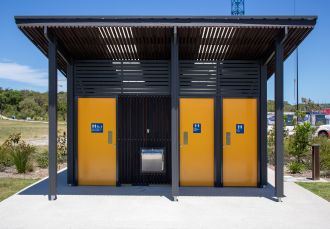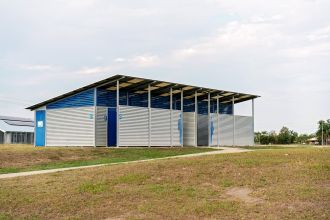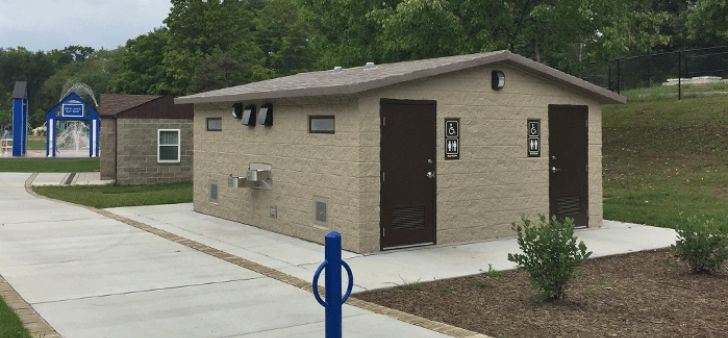When you gotta go, you gotta go. But where?
If you’re not providing a restroom for visitors to your park, you’re not just shortening the stay for regular visitors, you’re making your park off-limits for a wide variety of potential users.
Let’s talk details. The average person urinates seven or eight times a day, according to the Cleveland Clinic. If you’re sleeping eight hours a night, that means every two hours, on average. So even the average visitor to your park might need a place to go. But consider everyone else, too. Pregnant women, older folks, men with an enlarged prostate, and people with diabetes and other chronic illnesses all have to go more often, which means they might have to make plans based on restroom availability. And anyone with kids knows that a potty emergency can strike at any time.
Providing safe, well-maintained restrooms means everyone can feel comfortable using your park and its amenities. Premanufactured structures simplify the process of getting a facility up and running, whether you’ve got utility hookups (in which case you can find simple-to-install flush facilities), or yours is a more rustic location with no utilities available (in which case you can still find plumbed facilities, but can also go with a vault facility, with solar power to provide lighting and ventilation). 
Here are seven things to consider as you narrow down your list of potential restroom structure solutions for your site:
Site-Specific Considerations: Get prepared by getting knowledgeable about the typical use at your site. You’ll need to have a good idea of how many users to expect, as well as peak usage if there are days when the number of users in your park tends to grow. Do you have utility hookups, or will you need to install a structure without access to water or electricity? Knowing this information up front will help your supplier steer you toward the most effective facility to suit your site.
Durability: Restrooms take a lot of abuse, both from human nature and from mother nature. Make sure to choose a restroom structure that can stand up to these challenges. It should be manufactured to withstand the typical climate threats and the type of weather common in your area, whether that’s heavy snow loads in the mountains, hurricanes along the Gulf Coast, flooding along the Mississippi, or salt-laden air in coastal locations. To resist the abuses of humans—most typically graffiti and other types of vandalism—talk with your manufacturer about fixtures and design strategies that discourage miscreants, and are easy to clean up when graffiti does happen.
Safety: Safety is crucial. There are numerous ways to design restrooms to provide a safer environment. Single-occupant restrooms that lock are a smart consideration that can solve many issues. Not only do they provide an increased sense of security, allowing users to lock the door while the facility’s in use, they also solve problems presented by gendered restrooms, such as parents or caregivers with opposite-gender charges. What’s more, they can allow you to scale your operation, based on anticipated usage. If you have a facility that only experiences high traffic on certain days, like Fourth of July or Memorial Day, you can keep some of  your individual spaces locked, opening them up only when you anticipate more need. This will also help reduce your regular maintenance requirements. Lighting, vent screens, and installing your restroom in a highly visible area are other safety considerations.
your individual spaces locked, opening them up only when you anticipate more need. This will also help reduce your regular maintenance requirements. Lighting, vent screens, and installing your restroom in a highly visible area are other safety considerations.
Accessibility: In addition to being designed to ADA standards, there are other things you can do to improve accessibility to your restrooms. Make sure there is an accessible pathway to the restroom, and keep it close to other amenities, like a playground, parking lot, or exercise area. Consider installing adult changing tables. For more considerations on improving accessibility and inclusion at your park site.
Maintenance: If your restrooms aren’t well-maintained, with toilet paper restocked and trash emptied on a regular basis, folks will soon learn to avoid them. Create a regular maintenance schedule, based on the use of your park. Some restrooms might not need cleaning and restocking more than once a week. Others might require multiple visits in a day. Well-built premanufactured restrooms make it easy to keep things clean. You can often simply hose the facility down.
Sustainability: Talk to your supplier about ways to make your restroom structure more sustainable. Purchasing a durable solution will help ensure a longer life, reducing waste. Solar power can help run ventilation and lighting. Look for efficient fixtures, from metered or motion-sensor sinks to waterless urinals.
Aesthetics: The look of your restroom facility is just as important as the aesthetics of the rest of your site. Look for designs that fit well in the surrounding area. Manufacturers offer a wide range of exterior looks, from stone and river rock to brick, or simple block structures, with many color options to help ensure your restroom fits in with the rest of your park’s color scheme. RM
Story Sponsored by:
CXT Inc.



